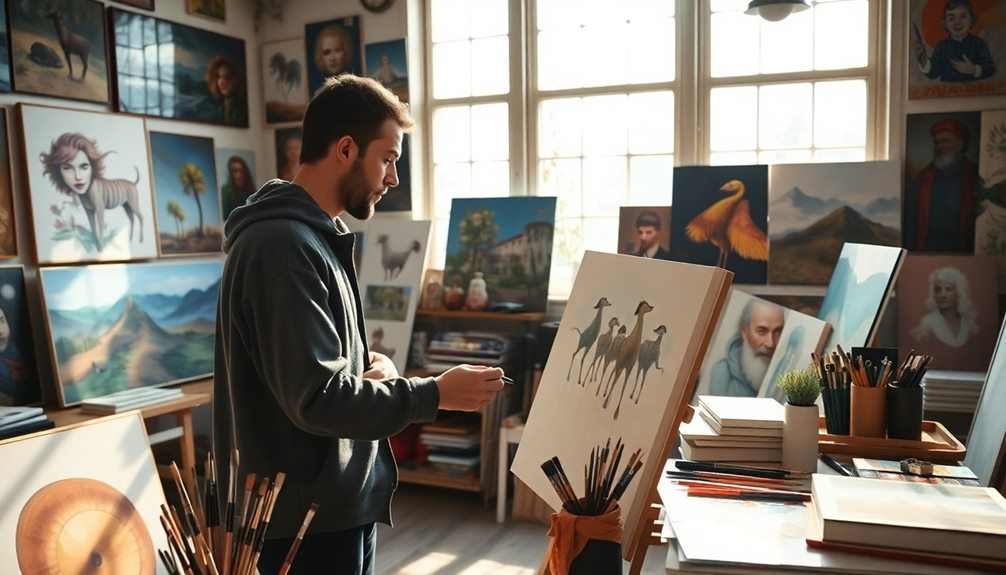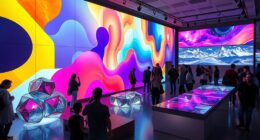In color theory, you learn how artists use color to evoke emotions, create harmony, and define visual impact. Understanding color symbolism helps you interpret artworks’ messages, while mixing techniques reveal the skill behind subtle hues. Recognizing color schemes like complementary or analogous schemes shows how artists craft mood and focus. Mastering these concepts deepens your appreciation of art, making each piece more meaningful. Keep exploring, and you’ll discover how color truly transforms your view of art.
Key Takeaways
- Color symbolism influences emotional responses and helps interpret an artwork’s message.
- Understanding color mixing techniques reveals artist’s skill and enhances visual harmony.
- Recognizing color schemes like complementary or analogous guides mood and focus in compositions.
- Knowledge of color relationships deepens appreciation of artistic intent and symbolic meaning.
- Mastering color theory enriches the overall viewing experience and emotional connection with art.

Color theory is the foundation for understanding how colors interact and influence each other. When you look at a painting or design, it’s helpful to recognize how color symbolism shapes your emotional response. For example, red often symbolizes passion, energy, or danger, while blue tends to evoke calmness, trust, or sadness. Recognizing these associations allows you to interpret artworks more deeply and appreciate the artist’s intent. Color symbolism isn’t just about what a color traditionally represents; it also depends on cultural context and personal experience. As you analyze a piece, think about the emotional or symbolic weight each color carries, which enhances your overall understanding of the artwork’s message.
Color symbolism influences emotional responses and deepens art interpretation.
Next, understanding color mixing techniques is essential for both artists and art appreciators. These techniques involve combining primary colors—red, blue, and yellow—to create secondary and tertiary hues. Knowing how colors blend helps you grasp the artist’s choices and the visual harmony or tension within a piece. For example, artists often mix colors to achieve specific shades that evoke certain moods or highlight particular elements. When you see a muted green or a vibrant orange, consider how the artist used color mixing techniques to produce those effects. Being familiar with these techniques also helps you decode subtle color variations and appreciate the skill involved in achieving the desired visual impact. Additionally, understanding affiliate marketing disclosures can help you identify genuine sources of art supplies and educational resources.
Color theory also emphasizes the importance of color relationships, such as complementary, analogous, and triadic schemes. These relationships influence how colors interact and how your eye perceives a composition. Complementary colors—those opposite each other on the color wheel, like red and green—create striking contrasts that can energize a scene. Analogous colors—those next to each other—offer harmony and unity. Recognizing these schemes enhances your ability to predict visual effects and understand the artist’s use of color to guide your focus or establish mood. As you become more familiar with these principles, you’ll find it easier to analyze and appreciate how color choices shape the overall impact of an artwork.
In essence, grasping color symbolism and mastering color mixing techniques deepen your engagement with art. They allow you to see beyond surface aesthetics and understand the deliberate choices behind each hue. Whether you’re creating your own art or simply enjoying others’ work, understanding these concepts helps you connect more meaningfully with visual art. You begin to notice subtle shifts in color and their emotional implications, enriching your appreciation and interpretation. By applying the principles of color theory, you turn every viewing experience into a more informed and rewarding journey through the vibrant world of art.
Frequently Asked Questions
How Do Cultural Differences Influence Color Perception in Art?
You should recognize that cultural differences greatly influence how you perceive color in art. Cultural symbolism and regional color meanings shape your interpretation and emotional response. For example, red might symbolize luck in China but danger in Western cultures. By understanding these cultural nuances, you appreciate the diverse ways colors communicate meaning and evoke feelings, enriching your overall art experience.
Can Color Theory Be Applied to Digital Art Effectively?
Imagine transforming your digital art like a master painter wielding a magic wand. Yes, you can apply color theory effectively to digital art by understanding digital color and using software palettes wisely. These tools help you create harmony, contrast, and mood, just like traditional mediums. Embracing color theory in digital art enhances your work’s impact, making it as vibrant and compelling as a masterpiece painted with a thousand brushes.
How Does Color Psychology Affect Viewer Emotions in Art?
You see, color psychology influences how you feel when viewing art. Different colors evoke specific emotional reactions, affecting your overall mood and perception of the piece. Bright hues can energize you, while cooler tones might calm or soothe. Understanding color emotionality helps you connect more deeply with art, as the colors used directly impact your emotional response. So, artists intentionally choose colors to shape your viewer mood and engagement.
Are There Universal Color Preferences Across Different Audiences?
You might wonder if everyone shares the same color preferences. While some cultural color symbolism influences how audiences respond to colors, personal color preferences vary widely based on individual experiences. These differences mean there aren’t universal color preferences across all audiences. Instead, your reactions depend on cultural backgrounds and personal associations, highlighting the complex relationship between color perception and individual or cultural influences.
How Do Artists Choose Color Schemes for Abstract Versus Realistic Art?
Think of Picasso’s daring choices versus a photorealistic portrait; your approach varies. For abstract art, you seek bold color harmony and striking visual contrast to evoke emotion and movement. In realistic art, you opt for subtle color relationships and natural hues to mirror reality. Your goal is to guide viewers’ eyes and feelings, choosing colors that fit each style’s intent while balancing contrast and harmony for maximum impact.
Conclusion
Once, I watched a painter mix colors to create a vibrant sunset. That moment made me realize how understanding color theory is like learning a secret language—one that unlocks the emotions behind every artwork. Just as the right shades can turn a simple scene into a masterpiece, mastering color theory lets you see beyond the surface. Embrace it, and you’ll find art becomes a more vivid, meaningful experience—like discovering a new world within every color.









